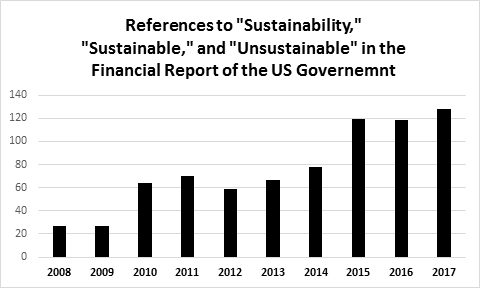
Here are some takeaways from the newly-released Financial Report of the US Government (2017).
- The GAO delivered another disclaimer of opinion on the government-wide financial statements. This was the 20th consecutive year for what is effectively a ‘flunk’ on your audit. GAO cited material weaknesses in “accounting for intergovernmental activity,” an “ineffective consolidation process,” and “serious financial management problems at the Department of Defense” that prevent the statements from being auditable.
- The GAO audit opinion took note of a new department-wide audit initiative at the Department of Defense, mainly reporting on what DoD has said it intends to do, without providing much evaluation or expectations.
- The term “material weakness” (in accounting and/or internal controls) appeared 65 times in this year’s report, down from 67 times last year. The total number of cited “material weaknesses” fell from 45 to 40.
- This year’s overall report was delivered despite the lack of financial statements from the Department of Energy, a huge department with significant defense-related programs, assets and liabilities, including massive obligations relating to reclamation of nuclear testing waste.
- Truth in Accounting’s estimate of the “true” national debt estimate rose from $95.5 trillion at 9/30/16 to $101.3 trillion at 9/30/17, given the results in the report. This one-year increase was about one-half the growth in the last year of the Obama administration, but deterioration nonetheless.
- The government’s estimate of its “fiscal gap” rose from 1.6% of GDP in 2016 to 2.0% of GDP in 2017. The fiscal gap measures the amount of tax increases / spending cuts needed to “make fiscal policy sustainable.” The government chooses to define “sustainable” as keeping the debt/GDP ratio from rising in the future.
- The government’s projected debt-to-GDP ratio at end of 75 years climbed higher still from 2015 and 2016. Rapid projected future increases in this ratio underlie the “sustainability” question.
- The reported budget deficit increased for the second consecutive year.

